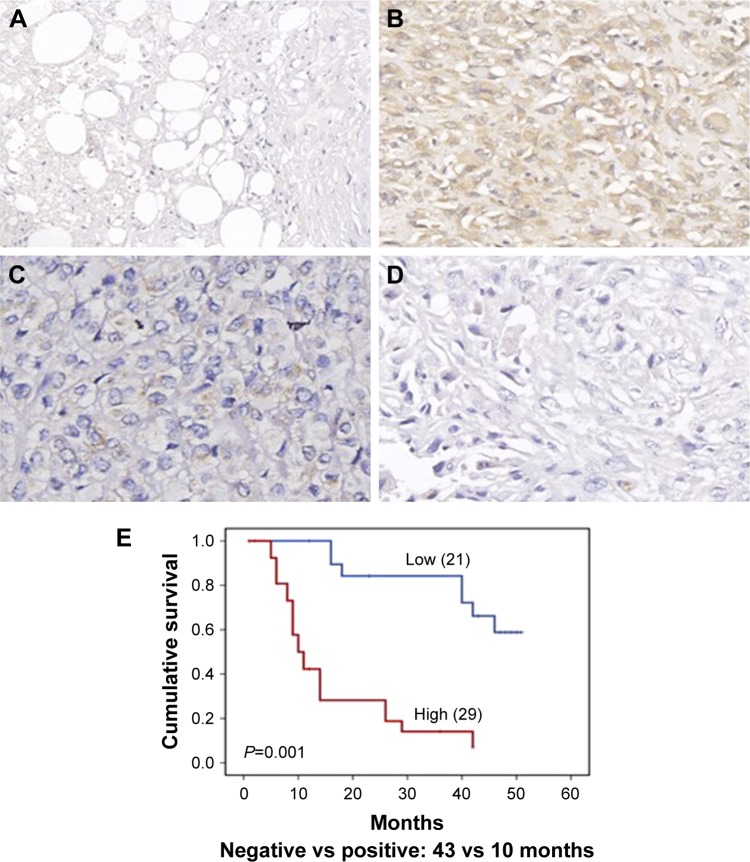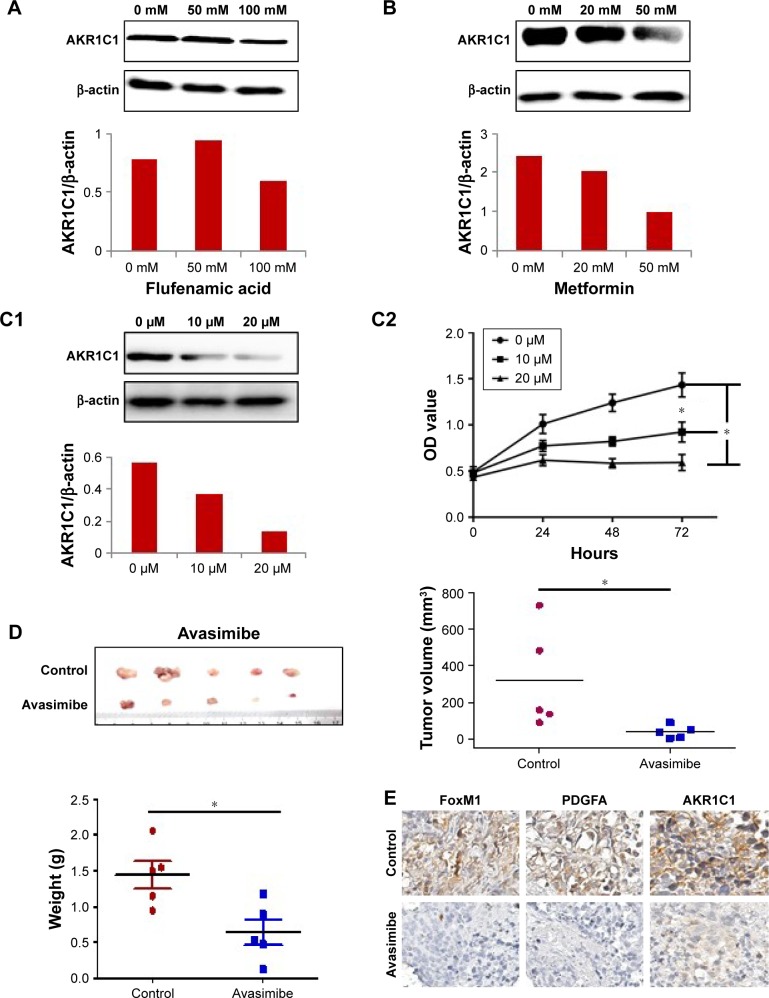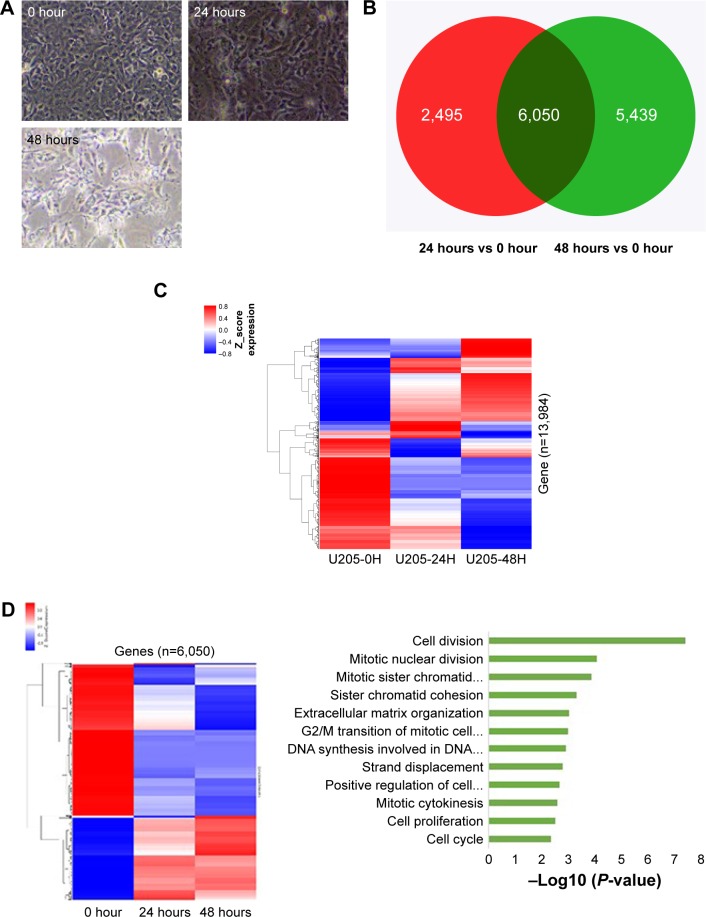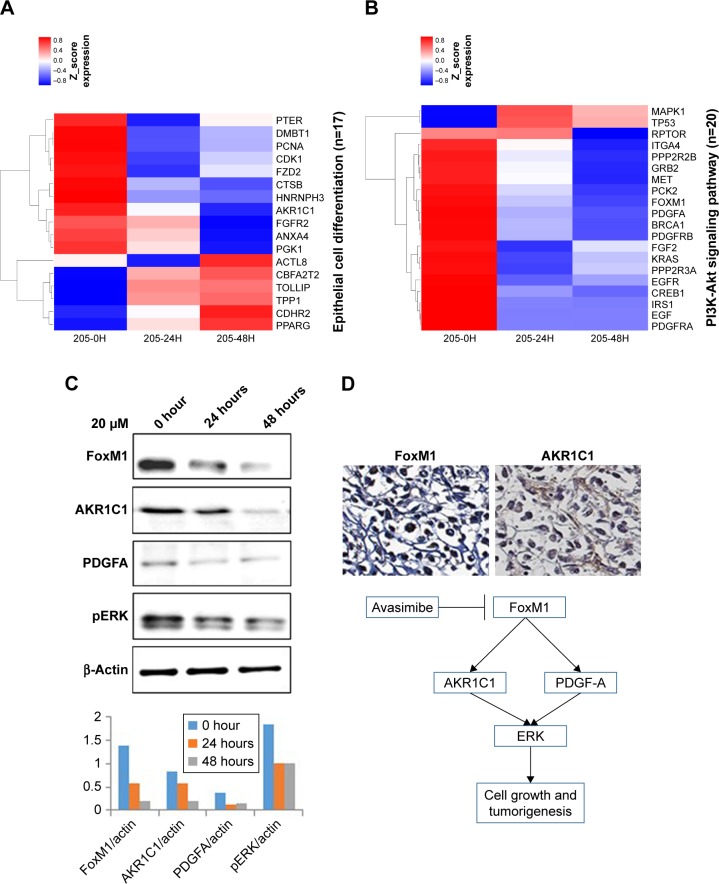Abstract
Background
Osteosarcoma (OS) is a rare bone tumor with a high propensity for lung metastasis and poor patient outcomes. It is crucial to identify novel therapeutic strategies and biomarkers.
Patients and methods
ARK1C1 staining was detected in OS specimens, and its clinical significance was assessed. A potential AKR1C1 inhibitor, avasimibe, was used to target AKR1C1.
Results
High expression of AKR1C1 was observed in OS and was associated with poor outcomes for patients with OS. Avasimibe was found to inhibit cell proliferation and tumor growth by reducing the expression of AKR1C1 and FoxM1 in vivo and in vitro.
Conclusion
These findings indicate that AKR1C1 is a promising prognostic factor and may serve as a novel therapeutic target of avasimibe for human OS.
Keywords: osteosarcoma, FoxM1, AKR1C1, immunohistochemistry
Background
Osteosarcoma (OS) is a rare bone tumor with a high propensity for lung metastasis and poor patient outcomes.1,2 This malignancy mainly affects adolescents and young adults. OS has a complex etiology, including genetic mutations and expression profiles, and environmental factors.2 Unlike those for other solid tumors, such as lung and colorectal cancers, systemic therapies for OS have not changed significantly in the past 30 years.1 The most widely used strategies still rely on varying combinations of the same four drugs, namely, high-dose methotrexate, doxorubicin, cisplatin, and ifosfamide.3 Understanding the molecular mechanisms that drive the development and progression of OS will shed light on the potential efficacy of additional agents such as immunotherapy and targeted therapies.
The proteins in the aldo-keto reductase (AKR) superfamily reduce carbonyl substrates, including sugar aldehydes; keto-steroids, keto-prostaglandins, retinals, quinones, and lipid peroxidation byproducts.4 Among these AKRs, AKR1C1–AKR1C4 catalyze NADPH-dependent reductions and have been implicated in biosynthesis, intermediary metabolism, and detoxification.5 Emerging evidence has implicated these four AKRs in cell sensitivity, growth, metastasis, and apoptosis in various tumors. AKR1C2 is most prominently expressed in breast cancer, endometrial cancer, and colorectal cancer.5 High levels of AKR1C3 can serve as a potential biomarker for the progression of prostate cancer.6 The role of AKR1C1 in carcinogenesis is complex. A number of studies have reported high expression of AKR1C1 in human prostate cancer, endometrial cancer, small cell lung cancer (SCLC), and non-SCLC.7–10 These findings suggested that these AKRs may be novel clinical targets for the treatment of cancer patients. However, a recent study showed low AKR1C1 expression to be significantly correlated with poor survival for patients with breast cancer.11 For this reason, more studies are needed to comprehensively assess the role of AKR1C1 in carcinogenesis.
Because the expression profile of AKR1C1 is rarely reported in OS, we investigated the status of AKR1C1 in OS and analyzed its clinical significance. We further aimed to identify its inhibitors by administering several well-known drugs. Finally, we showed avasimibe to be an effective AKR1C1 inhibitor, inhibiting AKR1C1 expression by targeting FoxM1.
Patients and methods
Human tissue samples
A total of 50 patients with OS who underwent curative surgery at Changzheng Hospital from 2004 to 2008 were enrolled in this study.12 Detailed medical records are listed in Table 1. The mean age of these patients at tumor resection was 18 years. Thirty-four patients (68%) were male and 16 (32%) were female. Forty-one received two or four cycles of preoperative chemotherapy (mainly methotrexate– cisplatin–adriamycin). Clinical follow-up information was available for all patients. The median follow-up was 22 months (ranging from 1 to 51 months). All the tissue samples in the present study were obtained with written informed consent, and the use of the tissues and clinical information was approved by the Changzheng Hospital Institutional Review Boards.
Table 1.
Association between AKR1C1 expression and clinicopathologic variables of osteosarcoma
| Variables | n | AKR1C1 high expression | P-value | FoxM1 high expression | P-value |
|---|---|---|---|---|---|
|
| |||||
| Tumor sizea | |||||
| >8 cm | 28 | 21 | 0.009 | 23 | 0.011 |
| ≤8 cm | 21 | 8 | 10 | ||
| Location | |||||
| Thigh bone | 14 | 8 | NS | 9 | NS |
| Tibia | 27 | 16 | 20 | ||
| Other | 9 | 5 | 4 | ||
| Differentiation | |||||
| Well/moderate | 36 | 19 | NS | 21 | 0.066 |
| Poorly/undifferentiated | 14 | 10 | 12 | ||
| Gender | |||||
| Male | 34 | 20 | NS | 19 | 0.028 |
| Female | 16 | 9 | 14 | ||
| TNM | |||||
| I/II | 43 | 25 | NS | 24 | |
| III | 7 | 4 | 7 | ||
Note:
The detailed tumor size of one case was not available.
This study was approved by the institutional review board of Changzheng Hospital.
Immunohistochemistry and evaluation of the results
Four-micrometer-thick sections of OS and ten adjacent noncancerous tissues were prepared and processed for anti-AKR1C1 (ANT-044, dilution, 1:100; ProSpec-Tany) staining as described previously.13 A Streptavidin–Biotin Kit (#KIT-9720; Maixin, Fuzhou, China) was used to visualize the status of antibody binding to the OS tissues. Hematoxylin was used to counterstain the nuclei. The primary antibody was replaced by PBS as a negative control. Two pathologists blind to clinical information evaluated the AKR1C1 staining independently under an Olympus CX31 microscope (Olympus, Center Valley, PA, USA). The mean percentage of positive tumor cells ranged from 0% to 100%. The staining intensity was defined as negative (0), weak (1), moderate (2), and intense (3). Lastly, a weighted score (%×intensity of staining) was generated for each case, ranging from 0 (0×0) to 3 (100%×3). Scores greater than 75 were considered to show high expression. Low expression was defined as scores ranging from 1 to 7.5.14
Cell culture and cell proliferation
The U2OS cell line was purchased from the Cell Center of the Chinese Academy of Sciences and maintained in DMEM with 10% FBS (Thermo Fisher Scientific) at 37°C in 5% CO2. Then 5,000 U2OS cells were seeded in 96-well plates and treated with metformin (0, 20, and 50 mM; Beijing Jingfeng Pharmaceutical Group Co., Ltd, Beijing, China), flufenamic acid (0, 50, and 100 mM; Energy Chemical, Shanghai, China), and avasimibe (0, 10, and 20 µM; Shanghai Super LAN Chemical Technology Center, China). Forty-eight hours after treatment, cells were trypsinized and 5,000 cells per well were seeded in 96-well plates. At 24, 48, and 72 hours after drug treatment, a cell counting kit-8 assay (Dojindo, Kumamoto, Japan) was performed to measure the absorbance, and relative cell viability was demonstrated in graphical representation.
Western blot analysis
Cells were treated with flufenamic acid, metformin, and avasimibe for 48 hours and whole-cell lysates were collected (P0013B; Beyotime, Shanghai, China). The lysates were resolved by SDS-PAGE and transferred electrophoretically to polyvinylidene difluoride membranes (Bio-Rad Lab., Hercules, CA, USA). The membranes were probed with AKR1C1 (ANT-044; ProSpec-Tany), FoxM1 (sc-500; Santa Cruz Biotechnology), PDGFRA (sc-338; Santa Cruz Biotechnology), and Phospho-ERK (Thr980) (16F8) (#3179; Cell Signaling Technology) antibodies, which were detected using an enhanced chemiluminescence kit (Santa Cruz, CA, USA).
Animal models
Subcutaneous tumor xenograft models were used to assess the inhibitory effect of AKR1C1 knockdown. U2OS cells were first trypsinized and suspended in PBS (1×106 cells in 0.1 mL PBS). These cells were injected subcutaneously into the right flanks of 4-week-old female Balb/c nude mice (n=10). One week later, these mice were divided into two groups: a control group and an avasimibe-treated group. Mice in the avasimibe-treated group were given avasimibe (30 mg/kg; 166518-60-1; Shanghai SuperLan Chemical Co., Ltd) by oral gavage for 21 days. All animals were euthanized and the tumors collected on the 22nd day. Tumor volume (mm3) was calculated as V=0.52 (length × width × depth). All animal experiments were performed in accordance with the National Institutes of Health Guide for the Care and Use of Laboratory Animals and were approved by the Animal Ethics Committee of the Second Military Medical University.
cDNA array
U2OS cells were treated with avasimibe at 20 µM. At 24 and 48 hours after treatment, total mRNA was collected from the control and experimental cells for cDNA microarray analysis. Gene expression profiling of the two groups was performed using the Affymetrix® Human Genome U219 Array. The average of signal intensity of Cy3:Cy5 of each spot was obtained and the ratio >1.5 or <0.67 was defined as the cutoff point to determine the upregulated or downregulated genes. Gene ontology analysis was performed to determine the most significantly changed genes of interest.
Statistical analysis
Statistical analysis was carried out using the SPSS 16.0 statistical software program for Microsoft Windows. Chi-squared tests were used for analysis of correlation between AKR1C1 expression and clinicopathologic variables. The Kaplan– Meier method was used to estimate the survival rates of OS patients. The significance of the in vitro or in vivo results was determined using the Student’s t-test (two tailed). A two-sided P<0.05 was defined as statistically significant.15
Results
AKR1C1 expression in patients with OS
The expression profile of AKR1C1 was investigated in a panel of 50 OS specimens and 10 matched noncancerous tissues using immunohistochemistry. AKR1C1 was predominantly localized at the cytoplasm. All noncancerous tissues were negative for AKR1C1 staining (Figure 1A). High expression of AKR1C1 was observed in 29 of 50 (58.0%) tumor specimens (Figure 1B and C), while the other specimens showed negative expression of AKR1C1 (Figure 1D).
Figure 1.
Expression of AKR1C1 in OS specimens.
Notes: (A) Negative staining of AKR1C1 in noncancerous tissues. (B) High expression of AKR1C1 in OS. (C) Weak expression of AKR1C1 in OS. (D) Negative expression of AKR1C1 in OS. IHC, ×200. (E) Patients with AKR1C expression had a shorter overall survival than those without AKR1C expression (negative vs positive: 43 vs 10 months; P=0.001).
Abbreviations: IHC, immunohistochemistry; OS, osteosarcoma.
Table 1 shows the correlation between AKR1C1 expression and clinicopathologic variables of OS. No significant relationship was observed between AKR1C1 expression and gender, tissue differentiation, tumor location, or disease stage. High AKR1C1 expression was only significantly associated with tumor size. AKR1C1 was more frequently overexpressed in larger tumors (75.0%) than in smaller ones (38.1%, P=0.009; Table 1).
Relationship of AKR1C1 expression to patient outcome in OS
The factors associated with overall survival were also analyzed in this cohort of 50 patients with OS. Among these variables, disease stage (by TNM) was found to be the only factor related to patient outcome (36 months for stage I/II vs 22 months for stage III; χ2=9.211, P=0.002). Patients with AKR1C1 high-expressing tumors had a shorter median survival than those with AKR1C1 low-expressing tumors (10 vs 43 months, P=0.001; Figure 1E).
Drugs inhibiting AKR1C1 expression
Several types of AKR1C1 inhibitors have been identified, including 3-bromo-5-phenyl salicylic acid, flavones, ruthenium complexes, and flufenamic acid. We selected flufenamic acid, a nonsteroidal anti-inflammatory drug that antagonizes AKR1C1 and decreases the invasive potential of metastatic bladder cancer cells,16 and two other popular drugs, metformin and avasimibe, to treat OS cells. However, flufenamic acid and metformin did not fully inhibit the expression of AKR1C1 (Figure 2A and B). Avasimibe also led to decreased expression of AKR1C1 and inhibited cell proliferation of OS cells (Figure 2C), suggesting that AKR1C1 may be a target of avasimibe.
Figure 2.
Inhibition of AKR1C1 expression by avasimibe treatment.
Notes: (A–C) U2OS cells were treated with (A) flufenamic acid, (B) metformin, and (C1) avasimibe. AKR1C1 was detected by Western blotting (C2). Cell proliferation was measured by CCK8 assay when administrated with avasimibe. *P<0.05. (D) U2OS cells (1×106 per mouse) were injected subcutaneously into the right flanks of nude mice (n=5 for each group). Mice were given avasimibe or regular water by oral gavage for 21 days. The tumor volume and tumor weight were examined at 22 days. *P<0.05. (E) The expression of FoxM1, PDGFA, and AKR1C1 was detected by IHC on these resected xenografts. IHC, ×400.
Abbreviations: CCK8, Cell Counting Kit-8; IHC, immunohistochemistry.
Avasimibe and inhibition of tumor growth in vivo
After administration of avasimibe for 21 days, we found that there were smaller tumors in the OS tumor-bearing nude mice treated with avasimibe, in comparison to the control counterparts (Figure 2D). The volume and weight of tumors in the avasimibe-treated mice were significantly lesser than those in the untreated mice (Figure 2D). The expression of FoxM1, PDGFA, and AKR1C1 was decreased in the tumors resected from avasimibe-treat mice compared with that from the untreated mice (Figure 2E).
Avasimibe-mediated impaired cell division revealed by gene expression analysis
Because avasimibe can lead to inhibition of cell proliferation and tumor growth, the transcriptional effects of avasimibe were assessed using cDNA array, by comparing the gene expression patterns in U2OS cells at 24 and 48 hours after avasimibe treatment to the gene expression pattern at baseline (Figure 3A and B). A number of genes were found to be significantly altered as indicated by gene ontology analysis. After clustering by the expression pattern, the most valuable cluster was found to be of genes involved in cell division (Figure 3C and D). Figure 4 shows potentially significant candidate genes involved in epithelial cell differentiation (Figure 4A) and in the PI3K-Akt signaling pathway (Figure 4B).
Figure 3.
Avasimibe treatment led to aberrant expression of genes related to cell division.
Notes: (A) Changes in cell morphology of U2OS after treatment with avasimibe for 48 hours. (B) U2OS cells were treated with avasimibe for 24 and 48 hours and subjected to cDNA array analysis. Intersection of genes between 24/0 and 48/0 hour. (C) Significant GO terms retrieved by clusters of genes involved in the union of B. (D) Significant GO terms retrieved by clusters of genes involved in the intersection of B.
Abbreviation: GO, gene ontology.
Figure 4.
Avasimibe treatment led to the inhibition of FoxM1-AKR1C1.
Notes: (A) Cluster of changed genes in epithelial cell differentiation. (B) Cluster of changed genes in PI3K-Akt signaling pathway. (C) U2OS cells were treated with avasimibe, and the protein levels of FoxM1, AKR1C1, PDGFA, and Phospho-ERK were detected by Western blotting. (D) Schematic diagram shows the mechanism underlying avasimibe inhibition of the FoxM1-AKR1C1/PDGFA, and Phospho-ERK signaling pathways.
Among these genes, AKR1C1 showed a continuous decrease over the course of 48 hours of avasimibe treatment. We also found that FoxM1, a transcription factor, and PDGFA, a downstream target of FoxM1, were also decreased by avasimibe treatment. Western blotting confirmed that avasimibe could inhibit the expression of FoxM1, AKR1C1, PDGFA, and Phospho-ERK proteins in OS cells (Figure 4C). Structural analysis revealed that the promoter region of AKR1C1 contains a number of FoxM1-binding motifs, indicating that AKR1C1 may be a downstream target of FoxM1 (data not shown). Therefore, our data suggest that avasimibe inhibited OS cell proliferation by targeting FoxM1-mediated transcription of AKR1C1 and PDGFA (Figure 4D).
Discussion
In the present study, we evaluated the expression profile and clinical significance of AKR1C1 in OS and evaluated potential AKR1C1 inhibitors. We demonstrated that AKR1C1 was highly expressed in OS and may be a prognostic factor for patients with OS. We showed avasimibe to be a novel and promising inhibitor of AKR1C1, which inhibited OS cell proliferation and tumor growth by targeting FoxM1. These results demonstrate the antitumor activity of avasimibe and its potential as a viable therapeutic strategy for patients with OS.
The AKR1C group of proteins is part of the AKR superfamily. They are mainly involved in steroid hormone metabolism, prostate-related hormone metabolism, and bile acid metabolism.5 AKR1C1/C2 and AKR1C3 can also metabolize tobacco carcinogens, as cigarette smoke particles can increase the expression of AKR1C1/C2 and AKR1C3 in oral squamous cells.17 In particular, AKR1C1 is highly expressed in a variety of human solid cancers, and overexpression of AKR1C1 promotes cell proliferation and migration of SCLC cells.7 Consistent with previous reports, we also found that AKR1C1 was overexpressed in OS specimens and significantly correlated with the poor prognosis of OS patients. All these data demonstrate that AKR1C1 plays a critical role in the development and progression of OS. The principal limitation of this study is the limited number of clinical samples available for assessment. A larger sample size will be required to determine if AKR1C1 expression may be used as a predictive biomarker of OS patient outcome.
The importance of AKR1C1 in OS makes it an interesting and promising target for cancer therapy. A number of AKR1C1 inhibitors have been developed. Here, we assessed three popular drugs: flufenamic acid, a nonsteroidal anti-inflammatory drug;16 metformin, a potential chemo-preventive drug;18 and avasimibe, an acetyl-coenzyme A acetyltransferase (ACAT) inhibitor,19 for their effect on OS cells. All three drugs were able to inhibit cell proliferation in a dose-dependent manner. It has been found that flufenamic acid can decrease cisplatin resistance and cell invasion of bladder cancer cells by antagonizing AKR1C1.16 However, we did not observe any inhibitory effects on AKR1C1 by flufenamic acid in our study. The anticarcinogenic effects of metformin have been well documented, but no inhibitory effects on AKR1C1 expression were observed following metformin treatment in our study. Avasimibe, however, was found to dramatically decrease the expression of AKR1C1. Avasimibe is an effective means of treating atherosclerosis and has been demonstrated to have an antitumor effect on melanoma cells.19 To further evaluate its role in vivo, we treated OS xenograft tumor-bearing mice with avasimibe. Not surprisingly, avasimibe treatment resulted in decreased tumor growth in vivo. Our data suggest that AKR1C1 is a potential target of avasimibe, which is a promising therapeutic alternative for human solid cancers.
Emerging evidence has indicated that avasimibe is not only an ACAT inhibitor but also an antitumor drug.19 We further explored the possible mechanisms underlying inhibition of cell proliferation and tumor growth by cDNA array. Without exception, avasimibe led to impaired cell division, cell proliferation, and slowing of the cell cycle. A number of genes related to cell proliferation were inhibited by avasimibe, including CCNG2, CCNB1, CDK1, Ki67, PCNA, and AKR1C1. Avasimibe led to dysregulation of key genes involved in PI3K-Akt signaling pathway. All these data confirm that avasimibe may have a role in the direct killing of tumor cells.
Among these avasimibe-targeted genes, we noticed that the level of FoxM1, a member of the Fox transcription factor family, was decreased by avasimibe, and that this decrease took place in a time- and dose-dependent manner. FOXM1 was found to be closely associated with the cell cycle, and FOXM1 overexpression was found to be associated with a less-favorable prognosis in the majority of solid, malignant cancers.20 FoxM1 promotes cell proliferation, migration, metastasis, and tumor growth by transcriptionally activating a number of genes, including PDGFA, ADAM17, ß-catenin, and ANXA1. We previously revealed that FoxM1 directly binds to two sites in the promoter of PDGFA and activates its transcription, which in turn leads to activation of the AKT pathway and increases the proliferation and tumorigenesis in breast cancer cells.21 PDGFA and PDGFRA/B were dysregulated by administration of avasimibe. These data indicate that avasimibe may directly target the FoxM1-PDGFA signaling pathway. Because the levels of both FoxM1 and AKR1C1 were decreased by avasimibe, we speculated that AKR1C1 may be a downstream target of FoxM1. Structural analysis revealed a number of FoxM1-binding sites in the promoter of AKR1C1, and FoxM1 increased the AKR1C1 promoter activity (ongoing studies). All these data suggest that avasimibe targeted FoxM1, leading to the inactivation of a number of genes, including PDGFA and AKR1C1.
In summary, this study showed that the AKR1C1 protein is frequently expressed in human OS and that it is a promising target for avasimibe. Avasimibe can suppress cell proliferation and tumor growth by targeting the FoxM1-AKR1C1 signaling pathway. Therefore, our data support the conclusion that avasimibe may be suitable for use in treating OS.
Footnotes
Disclosure
The authors report no conflicts of interest in this work.
References
- 1.Anderson ME. Update on survival in osteosarcoma. Orthop Clin North Am. 2016;47(1):283–292. doi: 10.1016/j.ocl.2015.08.022. [DOI] [PubMed] [Google Scholar]
- 2.Ottaviani G, Jaffe N. The etiology of osteosarcoma. Cancer Treat Res. 2009;152:15–32. doi: 10.1007/978-1-4419-0284-9_2. [DOI] [PubMed] [Google Scholar]
- 3.Lindsey BA, Markel JE, Kleinerman ES. Osteosarcoma overview. Rheumatol Ther. 2017;4(1):25–43. doi: 10.1007/s40744-016-0050-2. [DOI] [PMC free article] [PubMed] [Google Scholar]
- 4.Penning TM. The aldo-keto reductases (AKRs): overview. Chem Biol Interact. 2015;234:236–246. doi: 10.1016/j.cbi.2014.09.024. [DOI] [PMC free article] [PubMed] [Google Scholar]
- 5.Zeng CM, Chang LL, Ying MD, et al. Aldo-keto reductase AKR1C1-AKR1C4: functions, regulation, and intervention for anti-cancer therapy. Front Pharmacol. 2017;8:119. doi: 10.3389/fphar.2017.00119. [DOI] [PMC free article] [PubMed] [Google Scholar]
- 6.Tian Y, Zhao L, Zhang H, et al. AKR1C3 overexpression may serve as a promising biomarker for prostate cancer progression. Diagn Pathol. 2014;9:42. doi: 10.1186/1746-1596-9-42. [DOI] [PMC free article] [PubMed] [Google Scholar]
- 7.Tian H, Li X, Jiang W, et al. High expression of AKR1C1 is associated with proliferation and migration of small-cell lung cancer cells. Lung Cancer (Auckl) 2016;7:53–61. doi: 10.2147/LCTT.S90694. [DOI] [PMC free article] [PubMed] [Google Scholar]
- 8.Wang HW, Lin CP, Chiu JH, et al. Reversal of inflammation-associated dihydrodiol dehydrogenases (AKR1C1 and AKR1C2) overexpression and drug resistance in nonsmall cell lung cancer cells by wogonin and chrysin. Int J Cancer. 2007;120(9):2019–2027. doi: 10.1002/ijc.22402. [DOI] [PubMed] [Google Scholar]
- 9.Stanbrough M, Bubley GJ, Ross K, et al. Increased expression of genes converting adrenal androgens to testosterone in androgen-independent prostate cancer. Cancer Res. 2006;66(5):2815–2825. doi: 10.1158/0008-5472.CAN-05-4000. [DOI] [PubMed] [Google Scholar]
- 10.Rizner TL, Smuc T, Rupreht R, Sinkovec J, Penning TM. AKR1C1 and AKR1C3 may determine progesterone and estrogen ratios in endometrial cancer. Mol Cell Endocrinol. 2006;248(1–2):126–135. doi: 10.1016/j.mce.2005.10.009. [DOI] [PubMed] [Google Scholar]
- 11.Lewis MJ, Wiebe JP, Heathcote JG. Expression of progesterone metabolizing enzyme genes (AKR1C1, AKR1C2, AKR1C3, SRD5A1, SRD5A2) is altered in human breast carcinoma. BMC Cancer. 2004;4:27. doi: 10.1186/1471-2407-4-27. [DOI] [PMC free article] [PubMed] [Google Scholar]
- 12.Cheng L, Wei X, Zhao K, et al. The predictive potential and oncogenic effects of HOXC8 expression on osteosarcoma. Tumour Biol. 2016;37(11):14961–14967. doi: 10.1007/s13277-016-5384-4. [DOI] [PubMed] [Google Scholar]
- 13.Guan-Zhen Y, Ying C, Can-Rong N, Guo-Dong W, Jian-Xin Q, Jie-Jun W. Reduced protein expression of metastasis-related genes (nm23, KISS1, KAI1 and p53) in lymph node and liver metastases of gastric cancer. Int J Exp Pathol. 2007;88(3):175–183. doi: 10.1111/j.1365-2613.2006.00510.x. [DOI] [PMC free article] [PubMed] [Google Scholar]
- 14.Yu G, Yu W, Jin G, et al. PKM2 regulates neural invasion of and predicts poor prognosis for human hilar cholangiocarcinoma. Mol Cancer. 2015;14:193. doi: 10.1186/s12943-015-0462-6. [DOI] [PMC free article] [PubMed] [Google Scholar]
- 15.Chen Y, Xiang H, Zhang Y, Wang J, Yu G. Loss of PCDH9 is associated with the differentiation of tumor cells and metastasis and predicts poor survival in gastric cancer. Clin Exp Metastasis. 2015;32(5):417–428. doi: 10.1007/s10585-015-9712-7. [DOI] [PubMed] [Google Scholar]
- 16.Matsumoto R, Tsuda M, Yoshida K, et al. Aldo-keto reductase 1C1 induced by interleukin-1β mediates the invasive potential and drug resistance of metastatic bladder cancer cells. Sci Rep. 2016;6:34625. doi: 10.1038/srep34625. [DOI] [PMC free article] [PubMed] [Google Scholar]
- 17.Nagaraj NS, Beckers S, Mensah JK, Waigel S, Vigneswaran N, Zacharias W. Cigarette smoke condensate induces cytochromes P450 and aldo-keto reductases in oral cancer cells. Toxicol Lett. 2006;165(2):182–194. doi: 10.1016/j.toxlet.2006.03.008. [DOI] [PMC free article] [PubMed] [Google Scholar]
- 18.Yu G, Fang W, Xia T, et al. Metformin potentiates rapamycin and cis-platin in gastric cancer in mice. Oncotarget. 2015;6(14):12748–12762. doi: 10.18632/oncotarget.3327. [DOI] [PMC free article] [PubMed] [Google Scholar]
- 19.Yang W, Bai Y, Xiong Y, et al. Potentiating the antitumour response of CD8(+) T cells by modulating cholesterol metabolism. Nature. 2016;531(7596):651–655. doi: 10.1038/nature17412. [DOI] [PMC free article] [PubMed] [Google Scholar]
- 20.Dai J, Yang L, Wang J, Xiao Y, Ruan Q. Prognostic value of FOXM1 in patients with malignant solid tumor: a meta-analysis and system review. Dis Markers. 2015;2015:352478. doi: 10.1155/2015/352478. [DOI] [PMC free article] [PubMed] [Google Scholar]
- 21.Yu G, Zhou A, Xue J. FoxM1 promotes breast tumorigenesis by activating PDGF-A and forming a positive feedback loop with the PDGF/AKT signaling pathway. Oncotarget. 2015;6(13):11281–11294. doi: 10.18632/oncotarget.3596. [DOI] [PMC free article] [PubMed] [Google Scholar]






